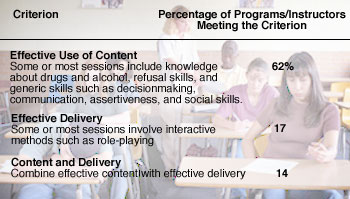Since 1994, U.S. schools have been able to use Federal funds to provide education programs designed to prevent drug abuse. Under amendments to the Safe and Drug-Free Schools and Communities Act (SDFSCA) in 1998, however, the schools receiving Federal grants for drug abuse prevention were required to use an evidence-based curriculum. There are several such curricula, incorporating elements proven to be effective in reducing teen drug use: information about the effects of illicit drugs, alcohol, and nicotine as well as information about social influences, refusal skills, assertiveness, and decisionmaking.
In 1999, shortly after the SDFSCA amendments took effect, NIDA-supported researchers found only one in four middle schools that offer drug abuse prevention programs met standards set in the Principles of Effectiveness. Dr. Christopher Ringwalt of the Pacific Institute for Research and Evaluation in Chapel Hill, North Carolina, Dr. Susan Ennett of the University of North Carolina, and colleagues surveyed more than 1,900 U.S. middle schools to assess the use of evidence-based programs. They found, Dr. Ringwalt says, that relatively few schools appear to consider research results when selecting programs. "Only about a third of the Nation's public schools and one-eighth of private schools are using substance prevention curricula for which there is evidence of effectiveness," he says.
 Most Middle School Prevention Programs Don't Combine Effective Content and Delivery. Of 1,795 instructors surveyed, only 1 in 7 (14 percent) provided programs that combined effective content with effective delivery in some or most sessions as defined in the Safe and Drug-Free Schools and Communities Act's "Principles of Effectiveness."
Most Middle School Prevention Programs Don't Combine Effective Content and Delivery. Of 1,795 instructors surveyed, only 1 in 7 (14 percent) provided programs that combined effective content with effective delivery in some or most sessions as defined in the Safe and Drug-Free Schools and Communities Act's "Principles of Effectiveness."The 1,656 public and 249 private schools surveyed all include some or all middle school grades (5 through 8). Respondents identified, from a list of 51 prevention programs, which program their school used. Programs on the list included 10 research-based programs identified as effective in reviews published by NIDA, the Center for Substance Abuse Prevention (CSAP), the Centers for Disease Control and Prevention (CDC), the Safe and Drug Free Schools Program of the U.S. Department of Education (SDFSP), or Drug Strategies, Inc. (DSI). The researchers also asked instructors to respond to questions about how the program was taught in the classroom.
Project Alert--identified as effective by CSAP, DSI, and SDFSP--was used by 19 percent of public and 6 percent of private schools. Life Skills Training--identified as effective by NIDA, CSAP, CDC, DSI, and SDFSP--was used by 12 percent of public and 3 percent of private schools. The most prevalent curriculum--used by 53 percent of public and 54 percent of private schools--is DARE (Drug Abuse Resistance Education), which has been extensively evaluated and found to be ineffective, Dr. Ringwalt observes.
Responses to questions about how the programs are taught suggest that only one school in five uses them to maximum advantage, according to Dr. Ennett. "To be successful, prevention programs need more than effective content," Dr. Ennett explains. "They also must be delivered effectively, by instructors who involve students in role-playing and other interactive, participatory activities. Unfortunately, we found that only about 21 percent of instructors used effective, interactive delivery."
In all, the researchers summarize, only one school in seven offers prevention programs that incorporate elements proven to be effective and delivers the content in the most effective way.
These findings paint a discouraging picture, observes Dr. Elizabeth Robertson of NIDA's Prevention Research Branch, but it may be improving. "Dr. Ennett and Dr. Ringwalt gathered their data only a year or so after the Department of Education issued the Principles of Effectiveness that could help schools select the most effective prevention programs. It's likely that more schools are now using materials that meet the guidelines for demonstrated effectiveness," Dr. Robertson says. "And instructors working with effective programs are likely to deliver the program content effectively. When both content and delivery are combined day-to-day in the classroom, we should begin to see, in studies such as the annual Monitoring the Future survey, major reductions in substance abuse among school-age youth."
Sources
- Ennett, S.T., et al. A comparison of current practice in school-based substance abuse prevention programs with meta-analysis findings. Prevention Science, in press.
- Ringwalt, C., et al. The prevalence of effective substance abuse prevention curricula in U.S. middle schools. Prevention Science 2(4):257-265, 2002. [Abstract]